UTA Plant Science Exam 2
1/131
Earn XP
Description and Tags
mama a girl behind you
Name | Mastery | Learn | Test | Matching | Spaced |
|---|
No study sessions yet.
132 Terms
how do plant cells and animal cells differ
plants have:
chloroplasts with [Circular DNA]
cell wall with cellulose
large central vacuole for water
plasmodesmata
the two parts of a plant cell
protoplast
cell wall
protoplast
plasma membrane and everything inside of it
cell wall
limits the enlargement of the protoplast
primary cell wall
all plant cells have this
made of cellulose
deposited during and after cell growth
allows for growth (flexible)
unevenly thickened
role in immune response
secondary cell wall
NOT in all cells
deposited only AFTER cell stops growth
almost always impregnated with lignin
not permeable to water
components of the primary cell wall
cellulose (all cells)
hemicellulose (polysaccharides)
pectins (polysaccharides)
glycoproteins
cutin, suberin, waxes
primary cell wall: Cellulose
long chains of glucose => microfibril => cellulose
depositzed by enzymes in the plasma membrane
deposited before and during cell growth
primary cell wall: Hemicellulose
polysaccharides
act as tethers holding the microfibrils together (flexy)
primary cell wall: Pectins
polysaccharides
cell adhesion and hydration
interwoven within the cell wall
primary cell wall: Glycoproteins & Enzymes
proteins help strengthen wall
breakdown cell wall components
defense against pathogens
primary cell wall: Middle Lamella
pectin- hydrophillic
external to primary cell wall
“glues” cells together
pause and draw a wall
image here
secondary cell wall characteristics
NOT present in all cells
strength and water conduction
deposited interior to the Primary cell wall
appears AFTER cell stops growing
more [cellulose] than in primary
lacks [plasticity]
no pectin
![<ul><li><p>NOT present in all cells</p></li><li><p>strength and water conduction</p></li><li><p>deposited<em> interior</em> to the Primary cell wall</p></li><li><p>appears AFTER cell stops growing</p></li><li><p>more [cellulose] than in primary</p></li><li><p>lacks [plasticity]</p><ul><li><p>no pectin</p></li></ul></li></ul><p></p>](https://knowt-user-attachments.s3.amazonaws.com/ea53dfec-11ec-422d-be26-d4c85f6ccf88.png)
secondary cell wall: Lignin
deposits provide compressive strength
prevents cell division/increase in size
how many layers does the secondary cell wall have?
3 layers
S1 S2 S3
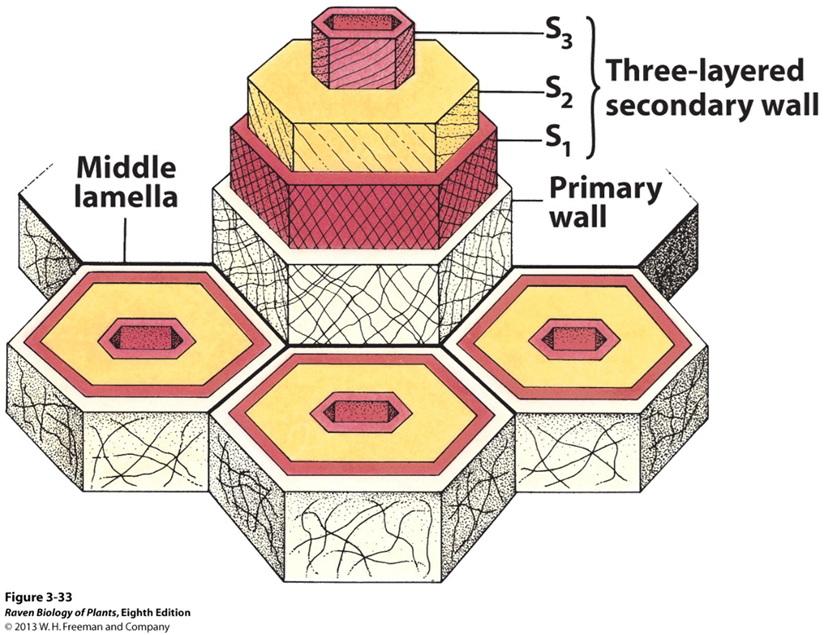
Imagine two plant cells capable of secondary growth. Starting from the cytoplasm of one cell, list the layers crossed as you travel to the cytoplasm of the second cell.
image here
pit-fields (Primary wall) and pits (Secondary wall)
openings in the cell wall that allow for exchange of materials between the cell, other cells, and the environment
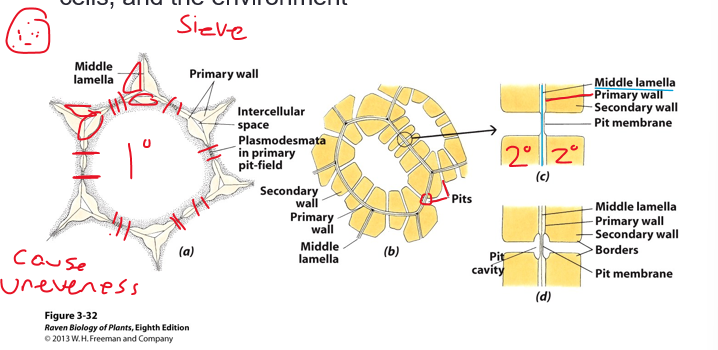
plasmodesmata
channels in the primary cell wall for intercellular communnication
has [desmotubules]
forms [symplast]
desmotubules
strands of endoplasmic reticulum
extends through the pits to connect adjacent cells
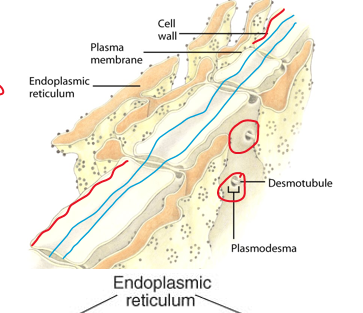
symplast
vast interconnected network of the protoplasm of ALL living cells in the plant
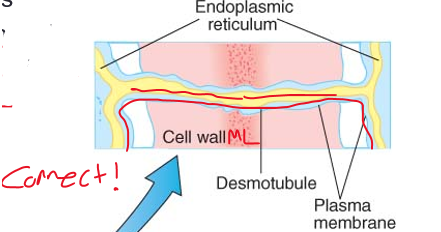
vacuoles
membrane-bound region filled with liquid (cell sap)
membrane is called [tonoplast]
may be 90% of cell volume
function:
maintain tissue rigidity
store primary and/or secondary metabolites
store pigments
may breakdown and recycle macromolecules
plastids
function in photosynthesis and storage
site of the synthesis of Some amino acids
have their circular DNA and ribosomes
DOUBLE MEMBRANE
divide by binary fission
are classified in part by the type of pigments they contain
plastids: chloroplasts
site of photosynthesis
contain [chlorophylls] and [carotenoids]
temporary starch storage
synthesis of other compounds
amino acids
fatty acids
metabolites
plastids: chromoplasts
lack chlorophyll
synthesize and store carotenoids and other pigments
highly colored (reds and oranges)
plastids: leucoplasts
non-pigmented
synthesize and store sugars as starch
amyloplast
specific type of leucoplast for storing starch in roots and tubers
plastids: proplastids
undifferentiated plastid
any type of plastid can convert from one type of plastid to another depending on the environment! (shapeshifters)
what two events are unique to plant cell cycles?
formation of the phragmosome
formation of a band of microtubules (preprophase band)
phragmosome
transverse sheet of cytoplasm
Formation of the phragmosome
move nucleus to the center of the cell
starts in the G1 phase of mitosis, just before DNA replication
nucleus is anchored in cytoplasmic strands
strands merge to form a phragmosome that bisects the cell where it will ultimately divide
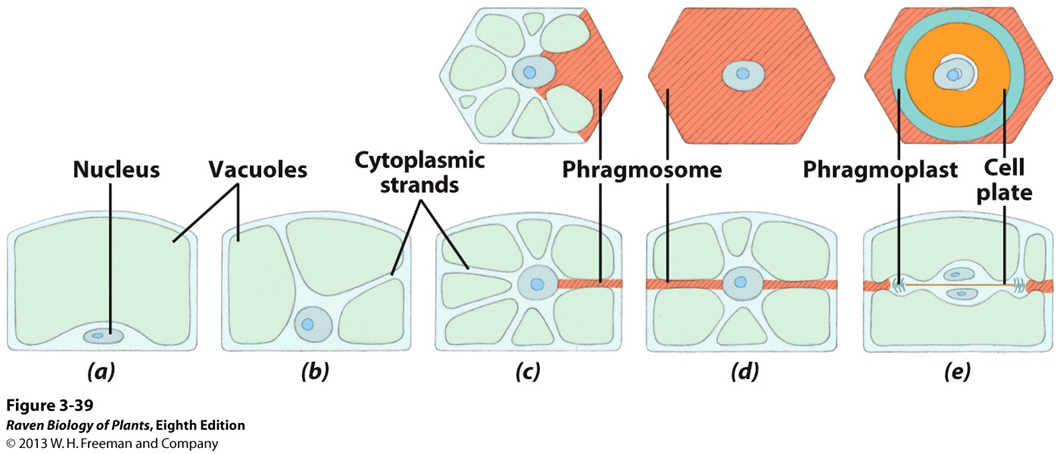
preprophase band
band of microtubules that guide the formation of the [cell plate]
cell plate
initial partition between daughter cells
formation of the preprophase band
ringlike band of microtubules forms just beneath the plasma membrane
encircles nucleus in a plane corresponding to equatorial plane of future mitotic spindle
occurs during G2, just before prophase
disappears AFTER prophase
plant cells may have all of the following EXCEPT:
chloroplasts
vacuoles
mitochondria
centrioles
centrioles
the ______ helps in building the cell plate when a plant cell divides:
cleavage furrow
preprophase band
plasmodesmata
phragmosome
preprophase band
the organelle that is responsible for maintaining tissue rigidity and storing many molecules like pigments is the:
endoplasmic reticulum
vacuole
vesicle
amyloplast
vacuole
potential energy
energy of chemical/electrochemical gradients across the plasma membrane
energy stored in chemical bonds
kinetic energy
energy released
anabolic
requires energy, building large molecules using smaller molecules
catabolic
releases energy, breaking down large molecules into smaller molecules
metabolism
ALL chemical processes that occur (both anabolic and catabolic) in a living organism
is respiration catabolic or anabolic?
catabolic pathway
glucose + O2 => CO2 + H2O + Energy
is photosynthesis catabolic or anabolic?
anabolic pathway
CO2 + H2O + Energy => glucose + O2
what are the 4 major stages of cellular respiration?
glycolysis
energy investment
energy payoff
pyruvate oxidation
the citric acid cycle
oxidative phosphorylation
what is the primary function of glycolysis?
function is to split sugar
glucose is split into two 3-carbon sugars called pyruvate (2 pyruvates made)
where does glycolysis occur in the cell?
occurs in the cytosol
is O2 required for glycolysis to occur?
no it takes place whether or not O2 is present
is CO2 released during glycolysis
no, CO2 is released during this process
what happens in the energy investment phase of glycolysis?
2 ATP is used to create 2 molecules of G3P from 1 glucose
what happens in the energy payoff phase of glycolysis?
2 NADH are formed as electron carriers for the ETC (electron transport chain) along with 2 ATP.
the final product of glycolysis is 2 pyruvates from 1 glucose
what is the function of pyruvate oxidation?
function is to oxidize pyruvate into Acetyl CoA
where does pyruvate oxidation occur in the cell?
occurs in the mitochondrial matrix (pyru)
what is the mechanism of pyruvate oxidation?
pyruvate moves into the matrix via active transport
oxidation of 1 pyruvate generates CO2, Acetyl-CoA, and 1 NADH for each pyruvate molecule
what is the function of the citric acid cycle?
function is to harvest high-energy electrons (e-)
where does the citric acid cycle occur in the cell?
occurs in the mitochondrial matrix (krebs)
what is the mechanism of the citric acid cycle?
the acetyl-CoA (reactant) is completely oxidized to CO2 (product)
1 ATP is generated per turn of the cycle by substrate-level phosphorylation (product)
most of the energy is transfered to 3 NAD+ and 1 FAD per turn of the cycle ===>>> 3 NADH and 1 FADH2 (products)
citric acid cycle (krebs cycle) mechanism part 2
1 glucose => 2 Acetyl-CoAs
for each Acetyl-CoA, 3 NADH and 1 FADH2 is created (electron carriers)
ATP is made by substrate-level phosphorylation
what is the function of oxidative phosphorylation?
function is to produce a hydrogen concentration gradient which powers ATP synthesis
where does oxidative phosphorylation occur in the cell?
occurs in the inner membrane of the mitochondrion
what are the major inputs of oxidative phosphorylation?
O2 and electrons from NADH and FADH2
what is the major output of oxidative phosphorylation?
ATP
Electron Transport Chain mechanism
electrons are carried by NADH and FADH into protein electron carriers embedded in the inner membrane
as electron moves to lower state of energy, the lost energy is used to pump (H+) out of the matrix and into the intermembbrane space
H+ supplies energy that drives ATP synthesis
ATP Synthesis (Chemiosmosis) mechanism
H+ ions have a tendency to diffuse back across the membrane down their electrochemical gradient, creating the proton motive force
as H+ ions flow through ATP synthase, ATP is produced
what is the formula for photosynthesis?
6 CO2 + 6 H2O + Light energy → C6H12O6 + 6 O2
where does photosynthesis take place?
in the chloroplast
what is chloroplast made of?
double membrane (inner and outer)
stroma
thylakoids
granum
stroma
interstitial liquid in the chloroplast surrounding the granum
dark reaction occurs here!
thylakoids
flattened, interconnected sacs in the chloroplast
light reactions occur in the thylakoid membranes
granum
a stack of thylakoids
why do leaves appear green?
the green color is the wavelength that doesn’t get absorbed
red and blue often gets absorbed
chlorophyll
the pigment in chloroplast that absorbs light, is what makes chloroplast green
chlorophyll a
the main essential pigment for photosynthesis
embedded in membrane proteins in the thylakoids of chloroplast
absorbs violet, blue, and red
reflects green
moves electrons (e-)
what are accessory pigments and name a few?
absorb light energy and work together to pass it to chlorophylls
chlorophylls b and c
carotenoids (orange carrot)
phycobilins
chlorophyll b
not directly involved in photosynthetic energy transduction
broadens spectrum of light absorption (DLC)
transfers energy to chlorophyll a
chlorophyll c
replaces chlorophyll b in some algae
brown algae
diatoms
purple bacteria
carotenoids
accessory pigment (DLC)
red, orange, and yellow lipid-soluble pigments
in ALL chloroplasts and cyanobacteria
embedded in thylakoid membranes
what is the order of the electromagnetic spectrum from shortest, highest energy to longest, lowest energy?
Gamma rays, X-rays, UV light, Visible light, Near-infrared, Infrared light, Microwaves, Radio waves
what happens when a pigment absorbs light?
it goes from ground state to an excited state, making it unstable
light-dependent reactions
occurs in thylakoid membrane
energy transduction reactions
energy of sunlight absorbed, converted into chemical energy (ATP & NADPH)
NADPH carries e- that are pushed to high energy levels by absorbed light
light independent reactions (dark reactions)
occurs in stroma
carbon fixation reactions
electrons in NADPH and ATP are used as a source of energy to convert inorganic CO2 to an organic form (CO2 fixation)
study this overview of photosynthesis
photosynthesis light reaction and dark reactions
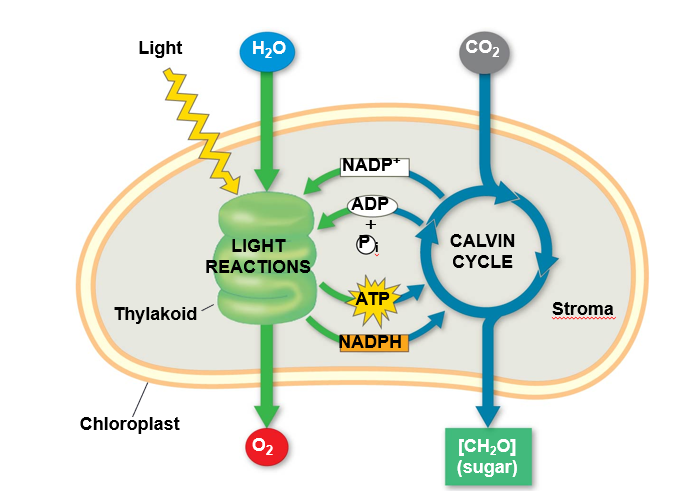
what two main processes are involved in the light reactions?
light absorption
synthesis of NADPH and ATP
what are photosystems?
pigment molecules embedded in the thylakoid membrane organized into discrete units
what two components do each photosystem have?
Antenna complex
Reaction center
antenna complex
pigment that funnel light energy through resonance to the reaction center
reaction center
chlorophyll molecules that enable light energy to be converted to chemical energy
photosystem II
P 680 pigment, contains very little chlorophyll b
light excites pigment, pigment use resonance to give energy to other pigment until it reaches chlorophyll a in the reaction center
P 680 in chlorophyll a excites, expels e- from reaction center
passes excited e- to ETC (plastoquinones) which pick up H+
“lost” e- are replaced by oxidation of water (oxygen-evolving complex unique to PS II)
e- deposited into mobile carrier, Plastoquinone
carrier deposits e- and H+ into the Cytochrome b6/f Complex
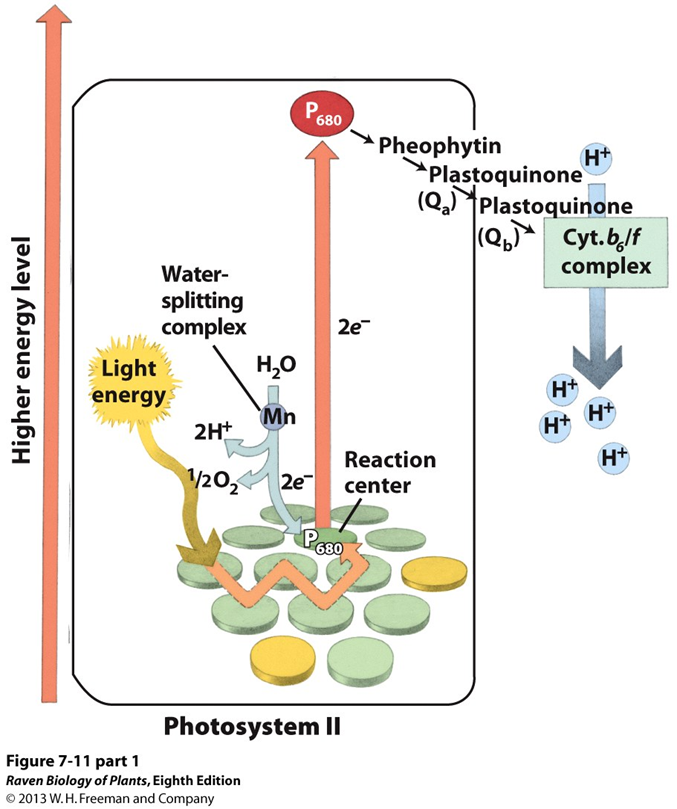
photosystem I
P 700 pigment, contains nearly as much chlorophyll b as a
light energy causes resonance in pigments in antenna complex
P 700 pigment in reaction center excites, ejects e- into a second ETC (Ferrodoxins, etc) and deposits NADP+
NADP+ is reduced to NADPH
lost e- is replaced by electrons carried from Cytochrome b6/f Complex
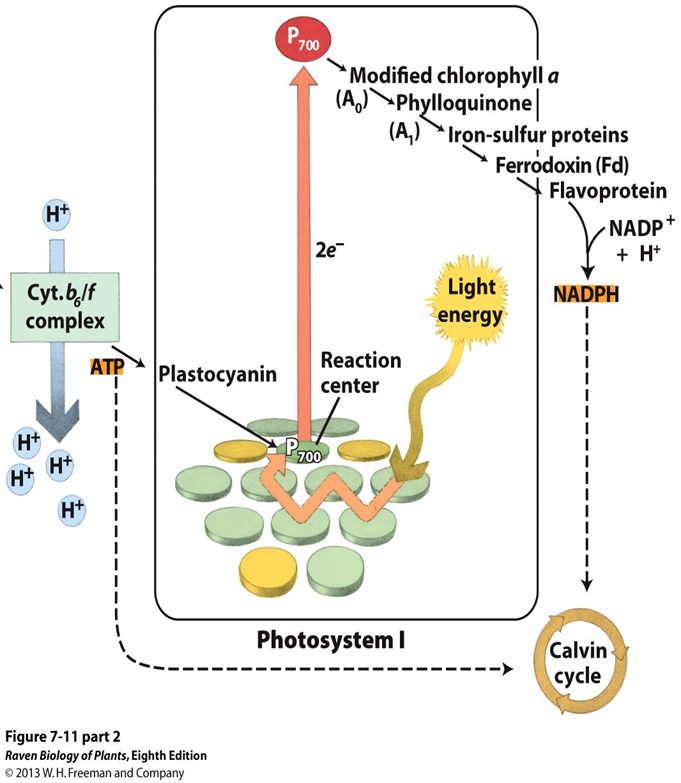
Cytochrome b6/f Complex
receives H+ from plastoquinone and deposits them into thylakoid lumen
receives e- from from plastoquinone
transfers electrons to another mobile electron carrier protein, Plastocyanin, which carriers electrons, one at a time to PS I
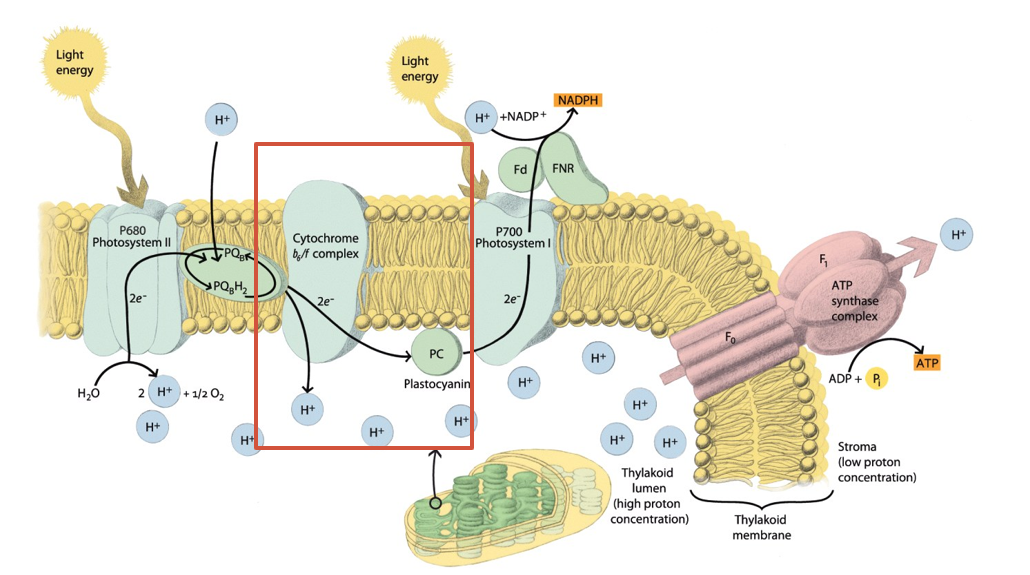
why does the Cytochrome b6/f Complex transfer H+ into the lumen?
the H+ is used for Photophosphorylation
linear (non-cyclic) electron flow
electrons flow continuously from water through photosystems II and I to NADP+, resulting in the oxidation of water to oxygen and reduction of NADP+ to NADPH
photophosphorylation
synthesis of ATP coupled to the transfer of electrons energized by photons of light
proton-motive force contributes energy for ATP synthesis by ATP synthase (chemiosmosis)
cyclic electron flow
makes ATP ONLY!
electrons cycle back into PS I reaction center via Cytochrome b6/f Complex
contributes to increasing proton concentration gradient (H+)
generates ATP, does not reduce NADP+
must occur to produce ATP necessary to drive Calvin cycle and other processes
more ATP than NADPH is needed in Calvin cycle
occurs only in PS I
cyclic electron flow part 2 (extra facts)
some organisms like purple sulfur bacteria have PS I ONLY
cyclic electron flow is thought to have evolved before linear electron flow
cyclic electron flow may protect cells from light-induced damage
light independent reactions: Carbon-Fixation
process in which inorganic carbon in the form of CO2 is converted into an organic molecule
ATP and NADPH, generated by light reactions, is used to fix and reduce carbon to synthesize simple sugars
C3 (three molecule fixing)
C4 (four molecule fixing)
CAM
how does CO2 get into plants?
CO2 is taken in through the stomata
diffuses into all open-air spaces in the mesophyll
dissolved into moist surface of spongy parenchyma cells
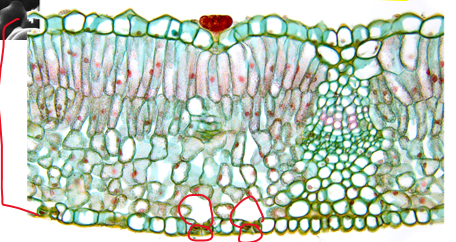
C3 Pathway
utilizes ONLY the Calvin cycle
fixes CO2 into 3-carbon molecule by feeding into a molecular cycle (Calvin cycle)
cycle starts AND ends with RuBP, 5 carbon sugar w/ 2 phosphate groups
catalyzed by RUBISCO (enzyme)
uses ATP and NADPH that was produced during light-dependent reactions
produces G3P molecule (3 carbons)
C3 inputs
3x RuBP
3x CO2
Rubisco enzyme
C3 outputs
1x G3P molecule
3-carbon precursor to glucose
AKA GA3P or PGAL (same thing!)
*5x GA3P remain in the cycle